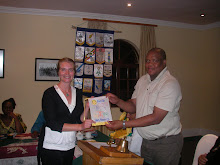I hope that for some of you, this title reminded you of the awesome show on PBS about 15 years ago called, “Where in the World is Carmen Sandiego.” That, not surprising now, was my favorite show- I was even in my grade school geography-bee because of it. And here I am traipsing around the world just like Carmen. Unfortunately, my geography knowledge failed me when I got my assignment four years ago as a Peace Corps Volunteer. I ripped open my assignment packet, “Yes, I’m going to Swaziland!”
“Where is Swaziland again…?”
According to my globe, Swaziland is a small country in Southern Africa almost completely surrounded by South Africa, except for the eastern side that borders Mozambique. It is about the size of New Jersey and has a population of about 1.1 million. Its economy is mostly agriculture based, with corn and sugar cane as it’s biggest exports.
It is actually called the Kingdom of Swaziland and is one of the last absolute monarchies. King Mswati III is the current king. Swaziland gained independence in 1948 from England. Back in colonial days it was considered a protectorate and made a rather peaceful transition out of colonial rule. Today the King has almost complete power. Political parties are banned, but there is an elected parliament. I think it’s a pretty American impulse to automatically think any non-democratic government is wrong, but some people strongly believe that the kingship and the preservation of the Swazi cultural structure is what kept Swaziland from civil unrest during independence, unlike so many of it’s African neighbors. If you are interested in learning more about this political tension, “Without the King” is a documentary that focuses on these issues.
While the kingship may have spared civil war, Swaziland continues to face many challenges. 66% of the population lives below the poverty line, and Swaziland has the highest rate of HIV in the world with a TB/HIV coinfection rate of 80%. HIV has wiped out a significant portion of the working population, as people of reproductive age (those most susceptible to HIV infection because they are sexually active) are also the most productive members of society. This affects the economy, but also contributes to a growing OVC population. OVCs are orphan and vulnerable children. Nercha, the national emergency response council on HIV/AIDS, estimates that 23% of all children in Swaziland have lost one or both parents and 31% are considered orphaned or vulnerable.
Swaziland is a beautiful country known for its incredibly friendly people. There are four regions in Swaziland: Hhohho, Manzini, Lobombo, and Shiselweni. I currently live in the Hhohho region. The capital city is Mbabane and the national language is Swati. SiSwati has 3 clicks and a series of other tricky sounds like hl, tf, and ts. And don’t forget about wildlife! Swaziland is home to 498 species of birds (so, Mom, I guess there are a few birds here after all!), the “Big 5” and many diverse indigenous trees and flora.
But I guess you could have gotten most of that information from a guide book… What do I like about the Kingdom of Swaziland? I like hopping onto a crowded khombi (like a small bus) that’s blasting music, drinking emahewu (a sour corn drink) at the end of a long, hot day, being called by my siSwati name: Jabulile Buthelezi, the stunning scenery, the amazing people, goofing around with Swazi kids, and the incredible sense of community I feel here.
I suppose it was worth the 23 hour flight… for the THIRD TIME!


















































nice! thanks for sharing!
ReplyDeleteI'm having a good time imagining you in a carmen sandiego hat...in swaziland...;)